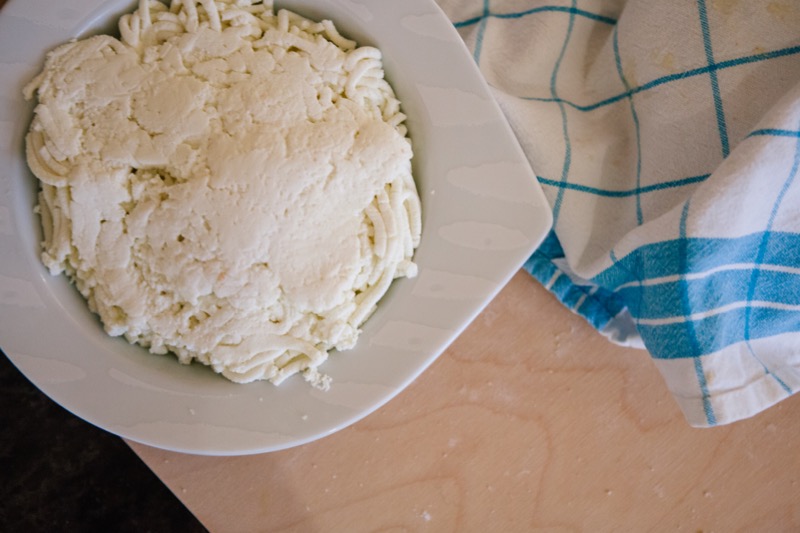Pierogi
As mother and daughter, Jadwiga and Izabela Lutostanska, from Szczecin, Poland, taught Lindsay Sterling in Brunswick, Maine.
Notes: If you will be making your own Polish farmer's cheese (it's easy) for the filling, you'll need to start the process the night before. You can find Polish farmer's cheese already made in a Polish market.
Pierogis freeze really well. It's great to make these in advance so all you have to do on the day you want them is make the topping and boil them.
Makes: about 70 dumplings, enough to serve for 6 for dinner or more as an appetizer or snack.
Cooking Time: 3-4 hours
Ingredients
For the filling:
- 3 cups Polish farmer's cheese (twarog), store bought or homemade
- 2 egg yolks
- 3 Tbsp powdered sugar
- 1 package vanilla sugar (subst. 1/2 tsp vanilla)
- (possibly 1-3 Tbsp milk)
For the dough:
- 1 1/3 cup milk
- 1 egg, whipped
- 3 1/2 cups flour + 2-4 Tbsp for dusting
- 1/2 tsp salt
For the toppings:
- 1 cup breadcrumbs
- 8 Tbsp butter
- 1 cup plain yogurt
- 4 Tbsp honey
- juice of 1/2 lemon
Instructions
Make the dough. Warm the milk. In a large mixing bowl, mix the milk and whipped egg into the flour and salt with your hands until you have a mass of globby, rough, sticky dough that sort of sags when you hold it up as opposed to stays in its shape. It's a wet dough. Spread flour across your cutting board or counter and put the blob of dough on it. Knead the dough for 15 minutes. Use a knife or pastry cutter to scrape any dough that sticks to the counter. You may dust some more flour to help contain the stickiness but keep in mind that you want the dough to end up tacky so that it will stick to itself when you are making the pierogis. Stop kneading when the dough is smooth, stretchy, and slightly tacky. It feels like a baby's bottom when it's done. Form the dough into a ball and cover it with a towel so that the dough doesn't dry out while you make the filling.
Make the filling. Mix the filling ingredients together: Polish farmer's cheese, egg yolk, powdered sugar, and vanilla sugar or vanilla. You want it to be creamy and uniform rather than crumbly. Depending on how dry your cheese is, you may need to mix in small amounts of milk until your filling comes together in a creamy uniform mass.
Form the pierogis. See this video on how to form the pierogis. Put a 1-2 Tbsp of flour off to the side of your workspace on the counter. Break off a piece of dough about the size of a small apple, or about a quarter of all the dough. Roll the piece into a snake shape about as thick as a nickel. Cut across the roll, making 3/4"-thick pieces of dough. Dip the fingers of one hand in the flour and use them to turn each segment on its side and pat down on top of it once with two fingers to begin to flatten the piece into disc.
Use a rolling pin to roll out each piece into your dumpling wrapper. What you want is a thin disk about 2 inches in diameter and about 1/8th inch thick. Put the disk in one hand, and add a tsp of filling to the middle of the disk. Fold both halves of the dough over the filling, match the edges on top of one another, and press them together, sealing the filling inside. If the filling gets on the edge of the dough where you are trying to seal it together, then the seal won't work. If you need to push the filling back from the edges, it's helpful to dip your finger in a little pile of flour before using them to nudge the filling out of the way because then the filling doesn't stick to your fingers. Then press the dumpling wrapper closed. Once the seal is secure, then pinch the dough six or seven times along the edge to make a pretty decoration.
If you are serving these another day, freeze pierogis in a single layer on a flour-dusted sheet pan. Once frozen, transfer into a Ziplock. Cook within 3 months.
On the day you want to eat them, prepare the toppings. Saute breadcrumbs in butter slowly on medium-low heat until breadcrumbs are golden. Remove from heat. Mix yogurt, honey, and lemon together in a bowl. If you're using Greek yogurt, whisk in a little water to loosen it into a sauce.
Boil the pierogis. Bring a pot of salted water to a boil. One by one, add enough pierogis to make a single layer in the water. Once they float, they're done. Another Polish source says she puts a tablespoon of oil in the water and then the pierogis don't stick to each other if you want to try cooking more at once.
Remove cooked pierogis with a slotted spoon or spatula and serve on a platter. Top with small splatters of yogurt sauce and buttered breadcrumbs.




















